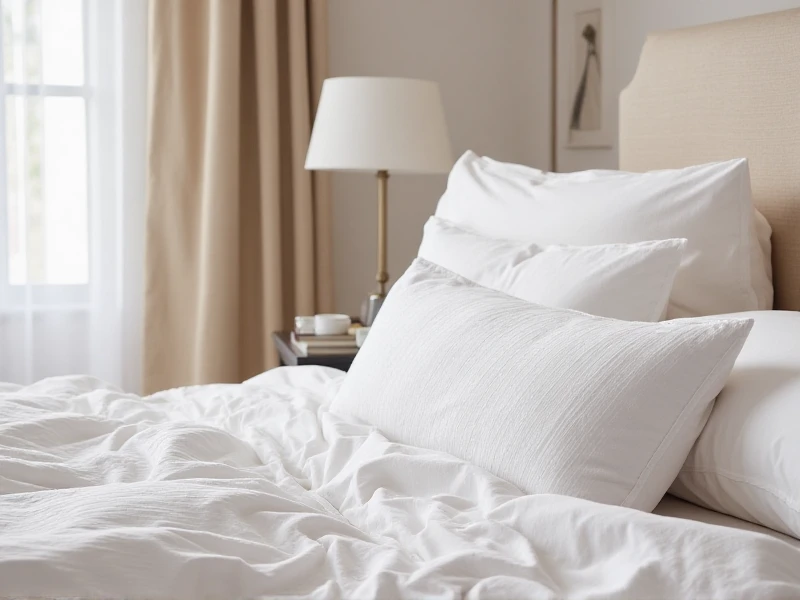The Ultimate Guide to Selecting Your Perfect Pillowcase
2025-06-01

They cradle your head for hours every single night. Yet, pillowcases often don't get the attention they deserve. Choosing the right pillowcase isn't just about the look – it profoundly impacts your sleep quality, skin health, hair condition, and overall comfort. If you've ever woken up with facial creases, frizzy hair, or feeling too hot or cold, your pillow cover might be the culprit. Understanding the differences is key to transforming your rest.
The cornerstone of pillowcase comfort and function lies in the material. Let's explore the most common options:
1. Cotton: The classic and widely popular choice.
Pros: Highly breathable, naturally absorbent, soft (especially as it breaks in), durable, and relatively affordable. Easy to care for and generally hypoallergenic.
Cons: Can wrinkle easily, especially lower thread count varieties. May not feel as silky-smooth as other fabrics. Quality varies significantly based on thread count (generally, higher is smoother and more durable, but 300-600 is often a good sweet spot) and weave (like crisp percale or soft sateen).
Best for: Those seeking reliable comfort, breathability, and value. Great for all seasons.
2. Linen: Made from the flax plant, linen offers a unique feel.
Pros: Exceptionally breathable and temperature-regulating – keeps you cool in summer and cozy in winter. Highly absorbent and gets softer with every wash. Naturally textured, durable, and resistant to pilling. Possesses natural antibacterial properties.
Cons: Typically expensive. Feels coarse initially (softens significantly over time). Wrinkles heavily – which many consider part of its relaxed charm, but may not appeal to everyone.
Best for: Hot sleepers, those prioritizing sustainability, lovers of natural textures, and those who appreciate long-term aesthetics and durability.
3. Silk (Mulberry Silk is best): The epitome of luxury for your pillow.
Pros: Unmatched smoothness minimizes friction against skin and hair, reducing frizz, creases, and potential skin irritation. Naturally temperature-regulating. Hypoallergenic and resistant to dust mites. Helps retain skin moisture.
Cons: The most expensive option. Requires delicate hand washing or machine washing on a gentle cycle. Can feel slippery to some. Shows water spots easily.
Best for: Those concerned about wrinkles, acne-prone skin, brittle hair, or frizz prevention. Perfect for anyone seeking a truly luxurious sleep surface.
4. Synthetic Fibers (Polyester, Microfiber, Bamboo-Viscose/Rayon): A broad category with varying characteristics.
Pros: Often very affordable. Frequently wrinkle-resistant and easy to care for (dries quickly). Can feel incredibly soft and silky, especially microfiber. Bamboo-derived rayon is marketed as breathable and moisture-wicking (though processing varies).
Cons: Generally less breathable than natural fibers, leading to potential overheating. Traps moisture, which isn't ideal for skin or regulating temperature. May generate static electricity. Less durable long-term than cotton or linen. Softness can sometimes feel artificial.
Best for: Budget-conscious shoppers, those seeking an easy-care, silky feel without the price tag of real silk.
Beyond Material: Weave & Details Matter
Weave: Sateen weave (like in some high-thread-count cotton) gives a lustrous, silky feel but can trap more heat. Percale weave offers a crisp, cool, matte feel. Jersey (knitted, like a t-shirt) is super stretchy and cozy.
Features: Consider enclosures! Envelope closures with a wide flap keep your pillow securely inside neatly. Simple open ends with a hem are standard but pillows can peek out. Look for reinforced seams for durability. Deep pockets are essential for thick pillows.
Size Matters: Getting the Right Fit
A well-fitting pillowcase ensures your pillow stays comfortable inside. Know your pillow size (Standard, Queen, King, Euro Square) and check the dimensions of the pillowcases you're buying. Deep pockets (around 20" or more) are crucial for thick pillows or those with filling that expands.
Caring For Your Pillowcases
Extend the life of your pillow covers and maintain their benefits:
Wash Frequently: Ideally, wash pillow protectors at least once a week to remove oils, sweat, and dead skin cells. Twice a week is even better for allergy sufferers.
Follow Care Labels: Especially crucial for silk and linen. Silk typically requires cold water delicate wash or hand washing and minimal/no heat drying. Cotton and synthetics can usually handle warmer water and tumble drying, but lower heat preserves colors and fibers.
Avoid Fabric Softeners: They coat fibers, reducing breathability and absorbency, and can irritate sensitive skin. Vinegar rinse can act as a natural softener and odor remover.
Rotate Pairs: Having at least two sets allows for easier rotation and washing cycles.
Investing in Your Sleep Sanctuary
Your choice of pillowcase is an intimate one, directly affecting your rest and well-being every night. Don't settle for scratchy polyester or rough, low-quality cotton. Consider:
What's your biggest sleep comfort issue? (Heat? Frizz? Skin sensitivity?)
What feel do you prefer? (Cool/crisp? Silky/smooth? Cozy/stretchy? Rustic/textured?)
What's your maintenance tolerance? (Easy-care vs. delicate washing)
What's your budget?
Once you've identified your priorities, material selection becomes much clearer. Investing in high-quality pillowcases made from natural, breathable, and skin/hair-friendly fabrics like cotton, linen, or silk can make a world of difference. It's a simple upgrade that pays dividends in how you look and feel every morning. Choose wisely and rest peacefully tonight!
Category: